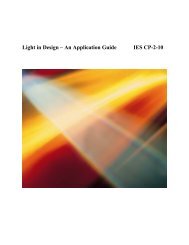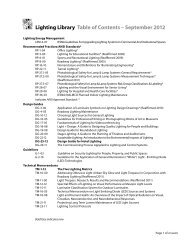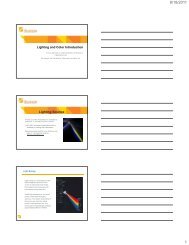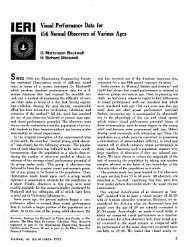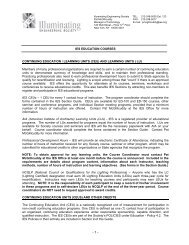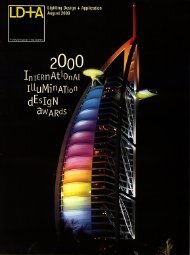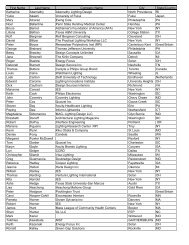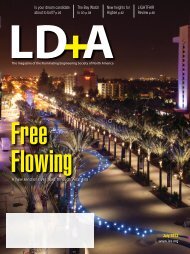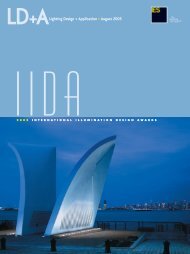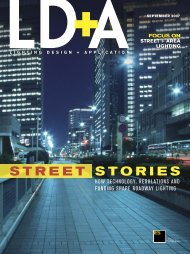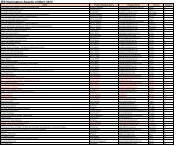faces of the future - Illuminating Engineering Society
faces of the future - Illuminating Engineering Society
faces of the future - Illuminating Engineering Society
You also want an ePaper? Increase the reach of your titles
YUMPU automatically turns print PDFs into web optimized ePapers that Google loves.
esearch<br />
BY JENNIFER A. VEITCH<br />
M A T T E R S<br />
In a previous column (March<br />
2008), I wrote about laboratory<br />
experiments that showed<br />
<strong>the</strong> benefits <strong>of</strong> individual, personal<br />
control over lighting. These<br />
experiments showed that giving<br />
people <strong>the</strong> opportunity to choose<br />
<strong>the</strong>ir own local lighting levels<br />
enables <strong>the</strong>m to create conditions<br />
closer to <strong>the</strong>ir personal preferences.<br />
Working in one’s preferred conditions<br />
leads to a more positive mood<br />
and to better satisfaction with lighting.<br />
In experiments supported by<br />
<strong>the</strong> Light Right Consortium (www.<br />
lightright.org), having individual<br />
control over lighting seemed to<br />
improve motivation over <strong>the</strong> workday;<br />
people without control showed<br />
a drop in motivation from morning<br />
to afternoon. Today, I can update<br />
you on our progress in studying<br />
<strong>the</strong>se effects in <strong>the</strong> field.<br />
When writing <strong>the</strong> final report for<br />
<strong>the</strong> Light Right Albany experiments,<br />
<strong>the</strong> team concluded that laboratory<br />
investigations <strong>of</strong> <strong>the</strong> effects<br />
<strong>of</strong> light distribution and individual<br />
control had reached <strong>the</strong> end <strong>of</strong> <strong>the</strong>ir<br />
usefulness (Boyce, et al., 2006;<br />
Boyce, Veitch, Newsham, Myer, &<br />
Hunter, 2003). To demonstrate <strong>the</strong><br />
overall organizational benefits <strong>of</strong><br />
high-quality, energy-efficient lighting<br />
in <strong>of</strong>fices would require a field<br />
study in a functioning work setting.<br />
Our team at NRC-IRC has now<br />
completed that study, with funding<br />
from <strong>the</strong> Light Right Consortium.<br />
The investigation was designed to<br />
achieve two objectives:<br />
1. To replicate <strong>the</strong> results <strong>of</strong> <strong>the</strong><br />
Light Right Albany experiments in a<br />
functioning work setting.<br />
2. To extend <strong>the</strong> model developed<br />
from <strong>the</strong> Albany data to organizational<br />
effectiveness outcomes.<br />
RESEARCH DESIGN<br />
The project was designed around<br />
a linked mechanisms map (Figure 1).<br />
As in <strong>the</strong> Albany experiments, each<br />
concept in <strong>the</strong> linked mechanisms<br />
map had at least one associated<br />
measurement.<br />
The experimental design was a<br />
naturally occurring field experiment<br />
in an organization that has undertaken<br />
a major renovation <strong>of</strong> three <strong>of</strong>fice<br />
buildings, involving both furnishings<br />
and lighting. Individual floors in all<br />
buildings will be renovated in phases<br />
over several years. During <strong>the</strong> study<br />
period (May 2008-September 2009),<br />
both old (pre-renovation) and new<br />
(post-renovation) conditions existed<br />
in <strong>the</strong> buildings. The old lighting<br />
consisted <strong>of</strong> recessed paraboliclouvered<br />
luminaires (similar to <strong>the</strong><br />
Base Case condition in <strong>the</strong> Albany<br />
experiment 1), and <strong>the</strong> new lighting<br />
consisted <strong>of</strong> workstation-specific,<br />
individually controllable, suspended,<br />
direct/indirect luminaires (similar<br />
to <strong>the</strong> Dimming Control condition<br />
in <strong>the</strong> Albany experiment 1).<br />
Furnishings also changed with <strong>the</strong><br />
lighting (from teal (dark) to <strong>of</strong>f-white<br />
(light)), except for four floors in one<br />
building that have had <strong>the</strong> new lighting<br />
for several years and that are<br />
keeping <strong>the</strong>ir medium grey panels.<br />
All <strong>of</strong> <strong>the</strong> buildings had large windows<br />
on all orientations. Figure 2<br />
shows examples <strong>of</strong> <strong>the</strong> old and new<br />
lighting and furnishings.<br />
All occupants <strong>of</strong> <strong>the</strong> three buildings<br />
were asked to complete an<br />
online questionnaire on three occasions<br />
during <strong>the</strong> study, in May-June<br />
2008, June 2009 and September<br />
2009. Each time, <strong>the</strong> questionnaire<br />
included questions and tasks to<br />
assess <strong>the</strong> individual-level concepts<br />
in <strong>the</strong> linked mechanisms<br />
map. Each measurement wave<br />
included a site visit by <strong>the</strong> research<br />
team, during which <strong>the</strong> physical<br />
conditions in selected locations<br />
were measured, with photometric<br />
measurements both by day and by<br />
night (electric lighting only). Some<br />
<strong>of</strong> <strong>the</strong> participants moved to newly<br />
renovated <strong>of</strong>fices between <strong>the</strong> first<br />
and second measurement waves;<br />
o<strong>the</strong>rs had already moved to new or<br />
newly renovated spaces before <strong>the</strong><br />
first wave; and o<strong>the</strong>rs did not experience<br />
any <strong>of</strong>fice design or lighting<br />
changes during <strong>the</strong> study period.<br />
As is evident from <strong>the</strong> photos,<br />
<strong>the</strong> three luminaire and furnishing<br />
combinations created markedly<br />
different visual conditions. (There<br />
were also three variations in <strong>the</strong><br />
operation <strong>of</strong> <strong>the</strong> workstation-specific,<br />
direct-indirect luminaires, which<br />
resulted in different proportions <strong>of</strong><br />
indirect illumination, but <strong>the</strong>se were<br />
small in comparison to <strong>the</strong> difference<br />
between workstation-specific,<br />
direct-indirect lighting and recessed<br />
parabolic louvered luminaires.)<br />
All <strong>the</strong> measured locations met or<br />
exceeded IES recommendations for<br />
work-plane illuminance. The <strong>of</strong>fices<br />
26 www.ies.org



